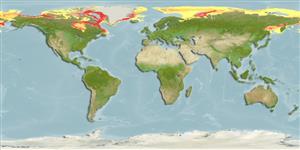Environment: milieu / climate zone / depth range / distribution range
Ecología
marino demersal; rango de profundidad 5 - 1038 m (Ref. 117245). Polar; 84°N - 50°N, 180°W - 180°E (Ref. 117245)
Arctic to Northwest Atlantic and Northwest Pacific: Canadian Arctic to Hudson Bay, Ungava Bay and Labrador in Canada (Ref. 7251). Arctic Ocean, Barents Sea, Franz Josef Land, Spitsbergen, eastern Greenland, Kara, Laptev, Siberian and Chukchi seas and the Sea of Okhotsk.
Tamaño / Peso / Age
Maturity: Lm ? range ? - ? cm
Max length : 10.0 cm SL macho / no sexado; (Ref. 4701)
Espinas dorsales (total): 7; Radios blandos dorsales (total): 11-13. Caudal fin rounded. Dorsal fin spines not visible (Ref. 4379). Olive, darker dorsally (Ref. 4379).
Found on mud, gravel or stone bottoms at temperatures below 0° C (Ref. 4701). Young occur in shallower water (Ref. 4701). Benthic; feed on crustaceans and oikopleura (Ref. 58426).
Life cycle and mating behavior
Madurez | Reproducción | Puesta | Huevos | Fecundidad | Larva
Stein, D.L., 1986. Cyclopteridae. p. 1269-1274. In P.J.P. Whitehead, M.-L. Bauchot, J.-C. Hureau, J. Nielsen and E. Tortonese (eds.) Fishes of the North-eastern Atlantic and the Mediterranean. UNESCO, Paris. Vol. III. (Ref. 4701)
IUCN Red List Status (Ref. 130435)
Threat to humans
Harmless
Human uses
Más información
ReferenciasAcuiculturaPerfil de acuiculturaRazasGenéticaElectrophoresesheritabilidadEnfermedadesProcesamientoNutrientsMass conversion
ColaboradoresImágenesStamps, Coins Misc.SonidosCiguateraVelocidadTipo de nataciónSuperficie branquialOtolitosCerebrosVisión
Herramientas
Special reports
Download XML
Fuentes de Internet
Estimates based on models
Preferred temperature (Ref.
123201): -1.2 - 2.9, mean 0.2 °C (based on 2662 cells).
Phylogenetic diversity index (Ref.
82804): PD
50 = 0.5000 [Uniqueness, from 0.5 = low to 2.0 = high].
Bayesian length-weight: a=0.02089 (0.00774 - 0.05639), b=3.03 (2.79 - 3.27), in cm total length, based on LWR estimates for this (Sub)family-body shape (Ref.
93245).
Nivel trófico (Ref.
69278): 3.3 ±0.34 se; based on food items.
Resiliencia (Ref.
120179): Medio, población duplicada en un tiempo mínimo de 1.4-4.4 años (Fecundity assumed < 1000).
Fishing Vulnerability (Ref.
59153): Low vulnerability (10 of 100).
